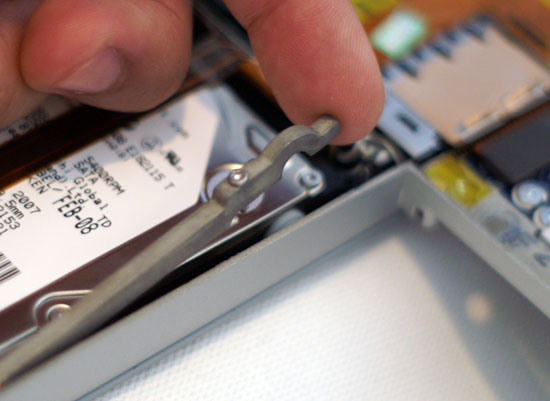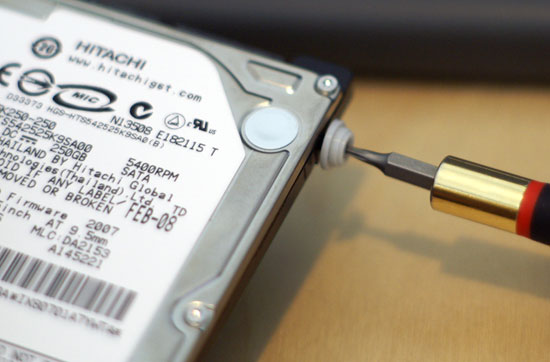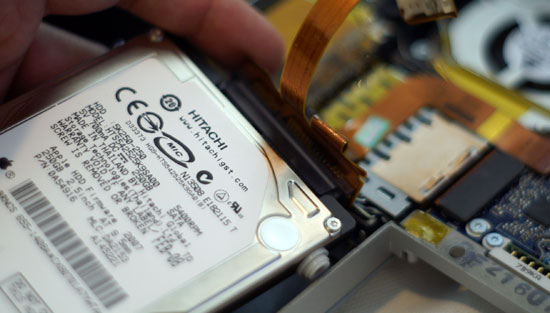Apple's MacBook Pro with 128GB SSD: Performance and Battery Life Investigated
by Anand Lal Shimpi on April 15, 2008 4:20 PM EST- Posted in
- Mac
Swapping Drives in a MacBook Pro
To swap drives in the MacBook Pro simply remove all of the exterior screws (including those behind the battery and memory expansion cover), pull up the keyboard and start working on the drive itself.
There's clamp that helps keep one side of the drive secure in the MacBook Pro; it's held in place by two Torx screws. With the clamp removed you can pull the old drive out, disconnect and peel off the cables stuck to the drive and transfer its screws to the new drive.

Remove this once you've cracked open the Pro

Lift the drive out, right side first

These screws on the left side of the drive need to be transfered to the new drive

...as do these screws + rubber case

Removing the sata cable

The new drive in place
The Test
| CPU | Clock Speed | L2 Cache | Memory | HDD | Graphics | |
| MacBook Pro 2.5GHz | Intel Core 2 Duo (45nm Penryn) | 2.5GHz | 6MB | 2GB DDR2-667 |
Hitachi Travelstar 5K250 (5400RPM) Memoright MR25.2+128S (SSD) |
NVIDIA GeForce 8600M GT 512MB |










39 Comments
View All Comments
Alexstarfire - Wednesday, April 16, 2008 - link
Efficiency != performance. You know that, right?JarredWalton - Wednesday, April 16, 2008 - link
Yeah. Using a custom IC means you don't have any extra transistors wasting space and power. An FPGA can do the same thing as a custom IC, but you usually have more gates available than you actually need.nubie - Tuesday, April 15, 2008 - link
I was under the impression that SATA used more electricity than PATA, no mention of that?We are going to need a dedicated low power mode for the chipsets and the SSD's
I wouldn't be surprised if these are all switched to a Mini PCIe card when this is mainstream. The added bulk, price and inefficiency of these in a 2.5" form factor is just plain dumb, besides, let it communicate over PCIe, then you wouldn't need to have a PATA-SATA etc interface.
mindless1 - Friday, April 18, 2008 - link
1) It would be very risky to design a laptop that didn't support 2.5" drives, a lot of the market isn't going to pay $4000 for their hard drive.2) You are obviously wrong about (significant) added bulk, that size is what allows the number of flash chips to reach capacity, the controller to improve performance, and the supporting electronics onboard. Of course there is a bit of space non-electronically *wasted* but so it goes with modular parts. When flash density increases again you could have smaller form factor with same capacity or you could have higher capacity. Also, a well optimized controller should parallelize access to the chips so more chips = better performance.
3) SATA vs PATA power consumption is not necessarily a difference enough to be significant in total device power consumption, although in this case with a PATA SATA bridge chip there is a small (probably under 50mA) consumption by that bridge.
4) You suggest comm over PCIe would be significant, that you wouldn't need PATA to SATA, but you would still need intermediary controller. Remember that SSDs are not developed for only one notebook, the market for a $4000 device is limited enough already so supporting the largest # of systems reasonably possible will help drive down prices.
5) What happens when you keep packing more and more active parts into a smaller space? Power density goes up and you then either need a fan or elaborate heatsinks scattered around and a lifespan degradation of other parts from running at higher temp. Not what people want when paying $5000 plus for a laptop.
In the end, SSD is still in it's infancy, think back to the improvements in mechanical drives made from the beginning until now. Ultimately if space savings becomes priority #1 they will just integrate the controller and flash chips onto the mainboard, forgoing the PCIe mechanical interface and parallel PCBs, that space consumption altogether.
Personally I think we need a new memory format similar to Compact Flash, with robust pin connectors, easily slotted and removable, and native SATA300 support. Next we need a portable Windows, so switching from your laptop environment and files to your desktop is just a matter of pulling card out of slot and plugging into the other system - or any other PC in the world for that matter. The crude precursors of this are already seen in mobile apps on USB thumbdrives but to be truely portable the whole OS environment needs be fully plug-n-play not what MS calls PNP.
quanta - Tuesday, April 15, 2008 - link
Last time I checked, even 8 sticks of Corsair Flash Voyager GT (16GB) flash drive cost less than $1000 total. Even with FPGAs and other extra electronics, the $3,819 price tag is a poor price excuse for extra performance. Considering that the drive doesn't even read and write at 8x the speed of Flash Voyager GT, you are better off using the extra cash to get better laptop options for other components.ltcommanderdata - Tuesday, April 15, 2008 - link
It's interesting that although your article mentions at the bottom of page 2 that and SSD would appear as just another hard drive, the DV Nation website lists the system requirements as OS X 10.5 being required. I guess they are just being conservative.I would like the response time of an SSD, but beyond the price, the storage capacity is still a bit constraining, even at 128GB. Personally, now that Fujitsu has announced 320GB 7200rpm 2.5" drives, I'm waiting on Hitachi to release an equivalent to replace my 160GB 5400 rpm Hitachi in my MacBook Pro. If I'm not mistaken Hitachi drives tend to be faster than Fujitsu.
Timothy123 - Tuesday, April 15, 2008 - link
Honda Civics do not depreciate that much, pretty bad example actually. Honda is known for it's high resale value and continued quality through high mileage and the test of time.You should have picked an American car to use in that metaphor, for instance, any car made by Ford or GM would have been a good choice.
A Ford Focus for instance, loses a lot more of it's value than a Honda Civic, hell for that matter, any American car loses it's value quicker than a Honda Civic.
Really really really bad example. Really bad.
xkon - Saturday, April 19, 2008 - link
lol. well... that kind of makes the statement true nonetheless. if the sdd depreciates in value 40% that means it depreciates a lot faster than a honda civic. if they'd chosen say... a dodge intrepid (my neighbor's '03 sold for $3000) or something like that, the depreciation value would be similar or over 40% defeating the purpose of the comment.Googer - Wednesday, April 16, 2008 - link
Tim,What the hell has that got to do with any thing in the article?
strikeback03 - Wednesday, April 16, 2008 - link
I had the same thought about the lack of depreciation on Civics when I read that line. And the fact that half the comments relate to that one sentence is humorous as well.